Mental Nursing Care: Therapeutic Relationships, Risk and Interventions
VerifiedAdded on 2023/06/08
|12
|3247
|84
Report
AI Summary
This report focuses on mental nursing care, specifically addressing the development of therapeutic relationships, assessment of patient needs, and the implementation of effective interventions. The report emphasizes the importance of understanding and active listening in building trust and rapport with patients. It explores various therapeutic interventions, including group therapy and multidisciplinary approaches, to manage conditions and promote patient well-being. Risk factors, such as low self-esteem, family difficulties, and social issues, are identified, along with key questions for assessing patient needs. The report highlights the significance of comprehensive care plans that address the mental, physical, emotional, social, and cultural needs of patients, while also emphasizing the need for nurse education, and family involvement.
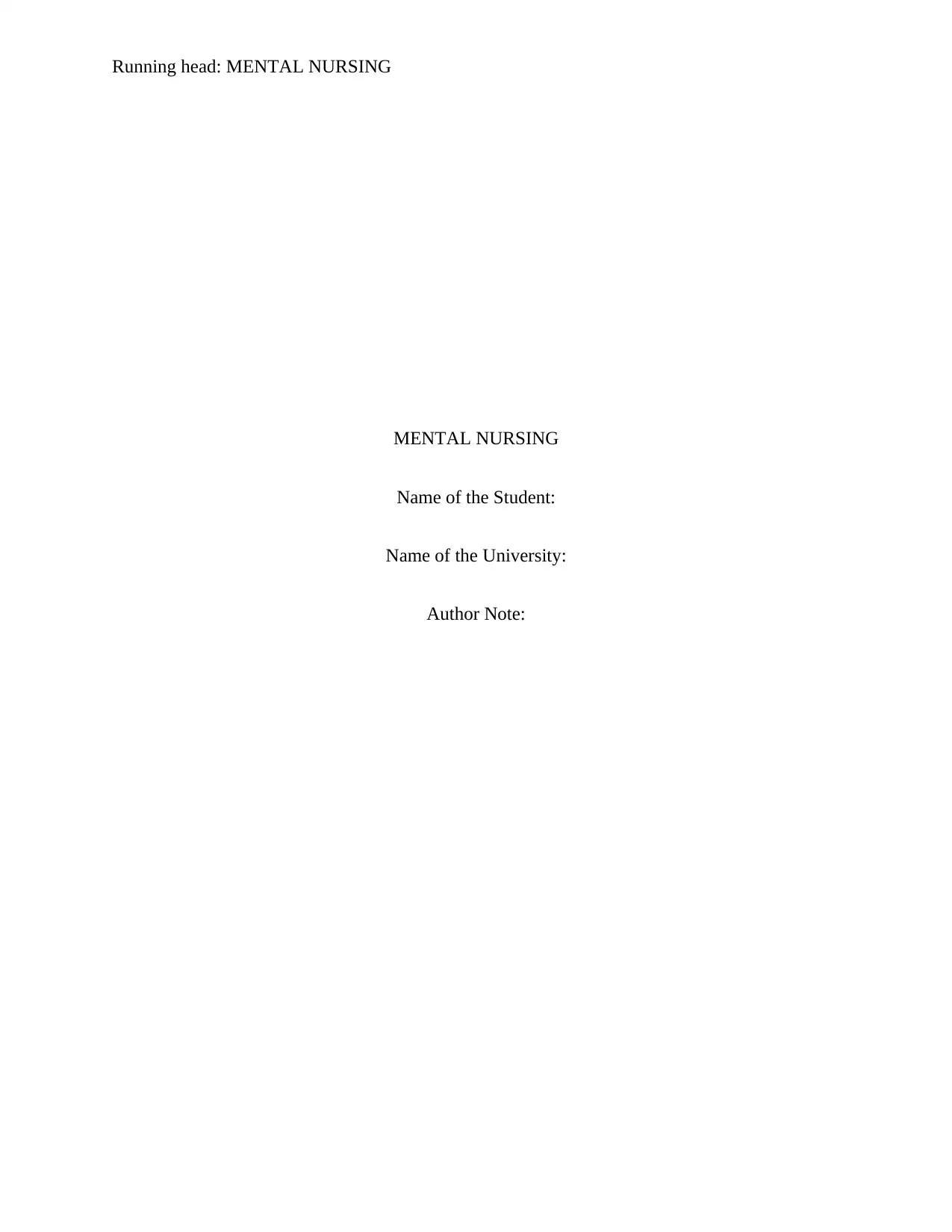
Running head: MENTAL NURSING
MENTAL NURSING
Name of the Student:
Name of the University:
Author Note:
MENTAL NURSING
Name of the Student:
Name of the University:
Author Note:
Paraphrase This Document
Need a fresh take? Get an instant paraphrase of this document with our AI Paraphraser
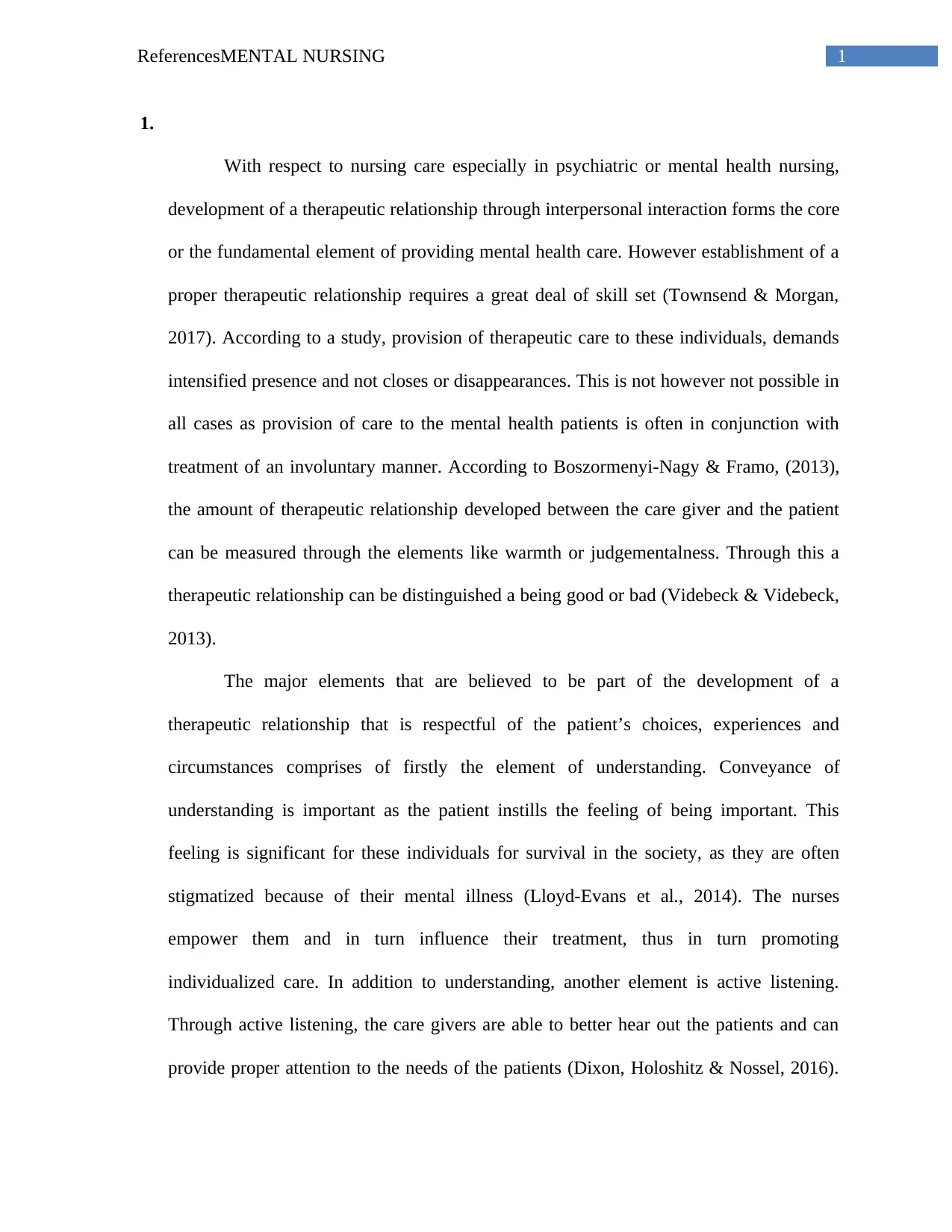
1ReferencesMENTAL NURSING
1.
With respect to nursing care especially in psychiatric or mental health nursing,
development of a therapeutic relationship through interpersonal interaction forms the core
or the fundamental element of providing mental health care. However establishment of a
proper therapeutic relationship requires a great deal of skill set (Townsend & Morgan,
2017). According to a study, provision of therapeutic care to these individuals, demands
intensified presence and not closes or disappearances. This is not however not possible in
all cases as provision of care to the mental health patients is often in conjunction with
treatment of an involuntary manner. According to Boszormenyi-Nagy & Framo, (2013),
the amount of therapeutic relationship developed between the care giver and the patient
can be measured through the elements like warmth or judgementalness. Through this a
therapeutic relationship can be distinguished a being good or bad (Videbeck & Videbeck,
2013).
The major elements that are believed to be part of the development of a
therapeutic relationship that is respectful of the patient’s choices, experiences and
circumstances comprises of firstly the element of understanding. Conveyance of
understanding is important as the patient instills the feeling of being important. This
feeling is significant for these individuals for survival in the society, as they are often
stigmatized because of their mental illness (Lloyd-Evans et al., 2014). The nurses
empower them and in turn influence their treatment, thus in turn promoting
individualized care. In addition to understanding, another element is active listening.
Through active listening, the care givers are able to better hear out the patients and can
provide proper attention to the needs of the patients (Dixon, Holoshitz & Nossel, 2016).
1.
With respect to nursing care especially in psychiatric or mental health nursing,
development of a therapeutic relationship through interpersonal interaction forms the core
or the fundamental element of providing mental health care. However establishment of a
proper therapeutic relationship requires a great deal of skill set (Townsend & Morgan,
2017). According to a study, provision of therapeutic care to these individuals, demands
intensified presence and not closes or disappearances. This is not however not possible in
all cases as provision of care to the mental health patients is often in conjunction with
treatment of an involuntary manner. According to Boszormenyi-Nagy & Framo, (2013),
the amount of therapeutic relationship developed between the care giver and the patient
can be measured through the elements like warmth or judgementalness. Through this a
therapeutic relationship can be distinguished a being good or bad (Videbeck & Videbeck,
2013).
The major elements that are believed to be part of the development of a
therapeutic relationship that is respectful of the patient’s choices, experiences and
circumstances comprises of firstly the element of understanding. Conveyance of
understanding is important as the patient instills the feeling of being important. This
feeling is significant for these individuals for survival in the society, as they are often
stigmatized because of their mental illness (Lloyd-Evans et al., 2014). The nurses
empower them and in turn influence their treatment, thus in turn promoting
individualized care. In addition to understanding, another element is active listening.
Through active listening, the care givers are able to better hear out the patients and can
provide proper attention to the needs of the patients (Dixon, Holoshitz & Nossel, 2016).
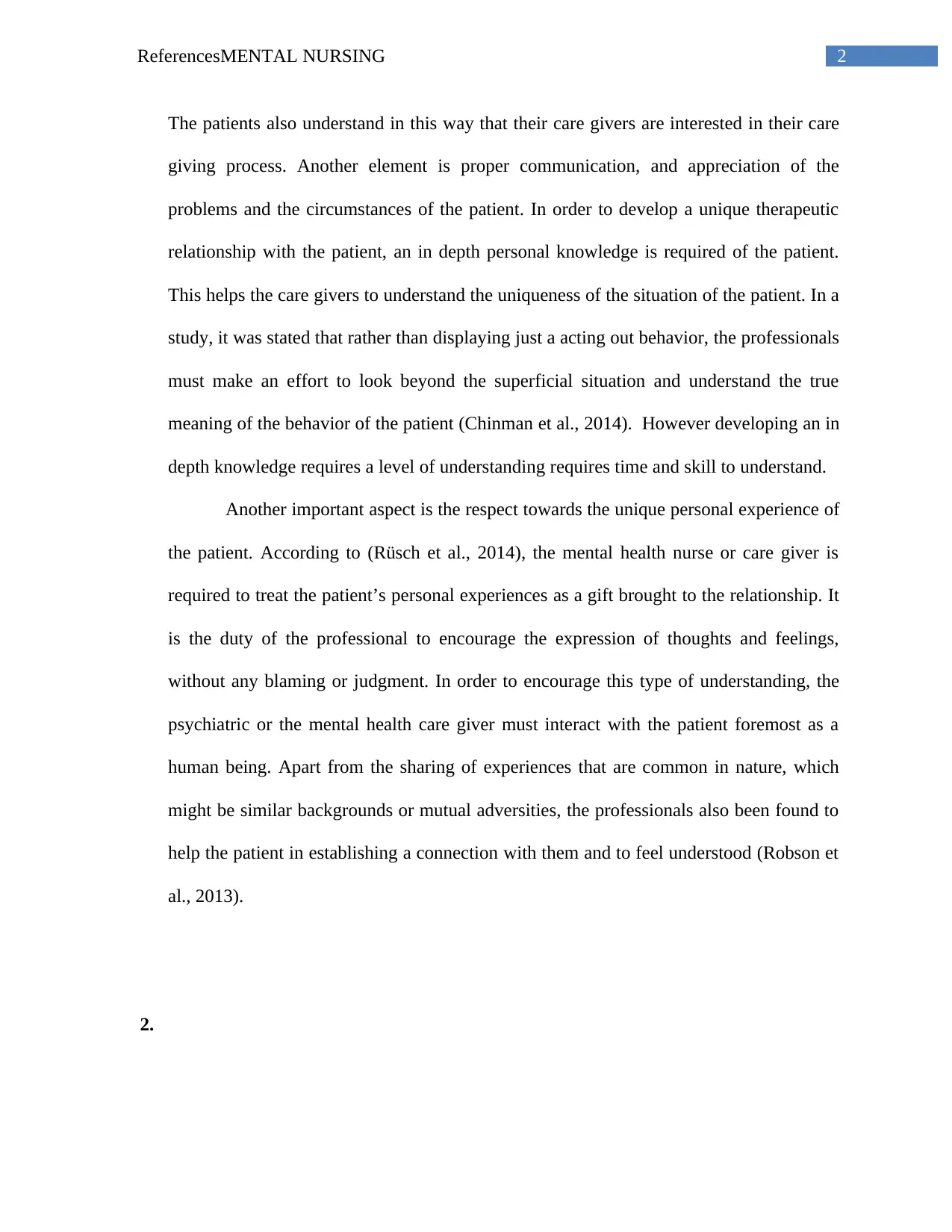
2ReferencesMENTAL NURSING
The patients also understand in this way that their care givers are interested in their care
giving process. Another element is proper communication, and appreciation of the
problems and the circumstances of the patient. In order to develop a unique therapeutic
relationship with the patient, an in depth personal knowledge is required of the patient.
This helps the care givers to understand the uniqueness of the situation of the patient. In a
study, it was stated that rather than displaying just a acting out behavior, the professionals
must make an effort to look beyond the superficial situation and understand the true
meaning of the behavior of the patient (Chinman et al., 2014). However developing an in
depth knowledge requires a level of understanding requires time and skill to understand.
Another important aspect is the respect towards the unique personal experience of
the patient. According to (Rüsch et al., 2014), the mental health nurse or care giver is
required to treat the patient’s personal experiences as a gift brought to the relationship. It
is the duty of the professional to encourage the expression of thoughts and feelings,
without any blaming or judgment. In order to encourage this type of understanding, the
psychiatric or the mental health care giver must interact with the patient foremost as a
human being. Apart from the sharing of experiences that are common in nature, which
might be similar backgrounds or mutual adversities, the professionals also been found to
help the patient in establishing a connection with them and to feel understood (Robson et
al., 2013).
2.
The patients also understand in this way that their care givers are interested in their care
giving process. Another element is proper communication, and appreciation of the
problems and the circumstances of the patient. In order to develop a unique therapeutic
relationship with the patient, an in depth personal knowledge is required of the patient.
This helps the care givers to understand the uniqueness of the situation of the patient. In a
study, it was stated that rather than displaying just a acting out behavior, the professionals
must make an effort to look beyond the superficial situation and understand the true
meaning of the behavior of the patient (Chinman et al., 2014). However developing an in
depth knowledge requires a level of understanding requires time and skill to understand.
Another important aspect is the respect towards the unique personal experience of
the patient. According to (Rüsch et al., 2014), the mental health nurse or care giver is
required to treat the patient’s personal experiences as a gift brought to the relationship. It
is the duty of the professional to encourage the expression of thoughts and feelings,
without any blaming or judgment. In order to encourage this type of understanding, the
psychiatric or the mental health care giver must interact with the patient foremost as a
human being. Apart from the sharing of experiences that are common in nature, which
might be similar backgrounds or mutual adversities, the professionals also been found to
help the patient in establishing a connection with them and to feel understood (Robson et
al., 2013).
2.
⊘ This is a preview!⊘
Do you want full access?
Subscribe today to unlock all pages.

Trusted by 1+ million students worldwide
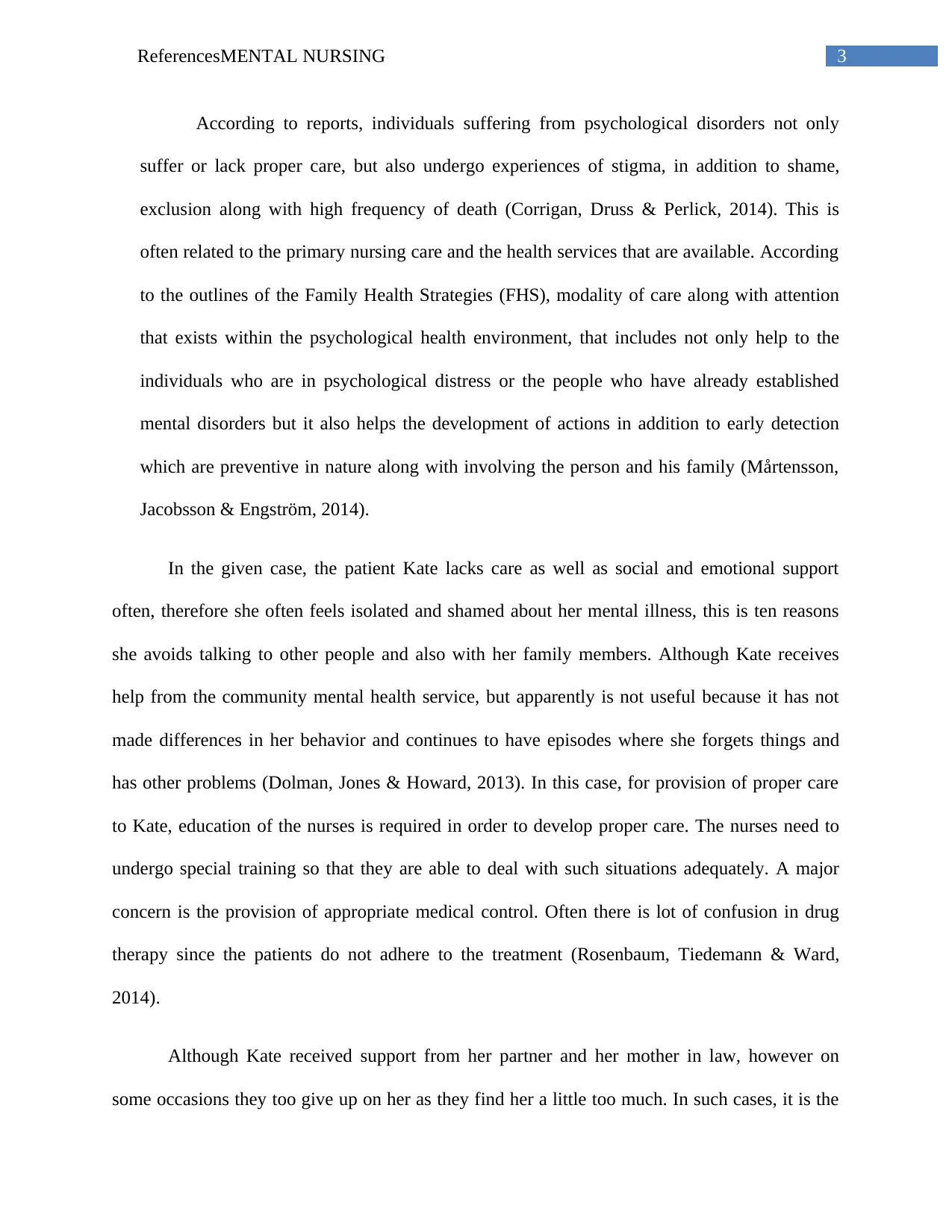
3ReferencesMENTAL NURSING
According to reports, individuals suffering from psychological disorders not only
suffer or lack proper care, but also undergo experiences of stigma, in addition to shame,
exclusion along with high frequency of death (Corrigan, Druss & Perlick, 2014). This is
often related to the primary nursing care and the health services that are available. According
to the outlines of the Family Health Strategies (FHS), modality of care along with attention
that exists within the psychological health environment, that includes not only help to the
individuals who are in psychological distress or the people who have already established
mental disorders but it also helps the development of actions in addition to early detection
which are preventive in nature along with involving the person and his family (Mårtensson,
Jacobsson & Engström, 2014).
In the given case, the patient Kate lacks care as well as social and emotional support
often, therefore she often feels isolated and shamed about her mental illness, this is ten reasons
she avoids talking to other people and also with her family members. Although Kate receives
help from the community mental health service, but apparently is not useful because it has not
made differences in her behavior and continues to have episodes where she forgets things and
has other problems (Dolman, Jones & Howard, 2013). In this case, for provision of proper care
to Kate, education of the nurses is required in order to develop proper care. The nurses need to
undergo special training so that they are able to deal with such situations adequately. A major
concern is the provision of appropriate medical control. Often there is lot of confusion in drug
therapy since the patients do not adhere to the treatment (Rosenbaum, Tiedemann & Ward,
2014).
Although Kate received support from her partner and her mother in law, however on
some occasions they too give up on her as they find her a little too much. In such cases, it is the
According to reports, individuals suffering from psychological disorders not only
suffer or lack proper care, but also undergo experiences of stigma, in addition to shame,
exclusion along with high frequency of death (Corrigan, Druss & Perlick, 2014). This is
often related to the primary nursing care and the health services that are available. According
to the outlines of the Family Health Strategies (FHS), modality of care along with attention
that exists within the psychological health environment, that includes not only help to the
individuals who are in psychological distress or the people who have already established
mental disorders but it also helps the development of actions in addition to early detection
which are preventive in nature along with involving the person and his family (Mårtensson,
Jacobsson & Engström, 2014).
In the given case, the patient Kate lacks care as well as social and emotional support
often, therefore she often feels isolated and shamed about her mental illness, this is ten reasons
she avoids talking to other people and also with her family members. Although Kate receives
help from the community mental health service, but apparently is not useful because it has not
made differences in her behavior and continues to have episodes where she forgets things and
has other problems (Dolman, Jones & Howard, 2013). In this case, for provision of proper care
to Kate, education of the nurses is required in order to develop proper care. The nurses need to
undergo special training so that they are able to deal with such situations adequately. A major
concern is the provision of appropriate medical control. Often there is lot of confusion in drug
therapy since the patients do not adhere to the treatment (Rosenbaum, Tiedemann & Ward,
2014).
Although Kate received support from her partner and her mother in law, however on
some occasions they too give up on her as they find her a little too much. In such cases, it is the
Paraphrase This Document
Need a fresh take? Get an instant paraphrase of this document with our AI Paraphraser
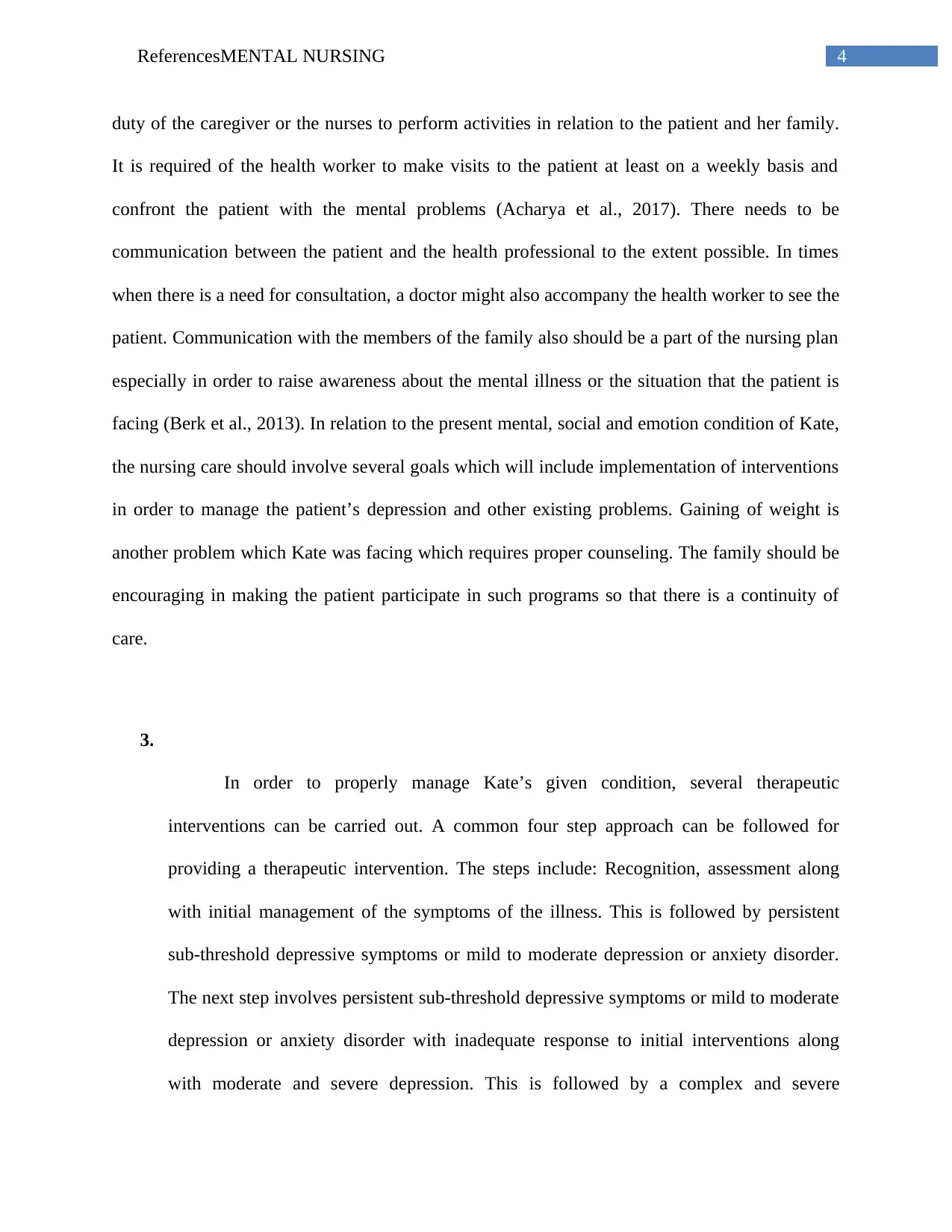
4ReferencesMENTAL NURSING
duty of the caregiver or the nurses to perform activities in relation to the patient and her family.
It is required of the health worker to make visits to the patient at least on a weekly basis and
confront the patient with the mental problems (Acharya et al., 2017). There needs to be
communication between the patient and the health professional to the extent possible. In times
when there is a need for consultation, a doctor might also accompany the health worker to see the
patient. Communication with the members of the family also should be a part of the nursing plan
especially in order to raise awareness about the mental illness or the situation that the patient is
facing (Berk et al., 2013). In relation to the present mental, social and emotion condition of Kate,
the nursing care should involve several goals which will include implementation of interventions
in order to manage the patient’s depression and other existing problems. Gaining of weight is
another problem which Kate was facing which requires proper counseling. The family should be
encouraging in making the patient participate in such programs so that there is a continuity of
care.
3.
In order to properly manage Kate’s given condition, several therapeutic
interventions can be carried out. A common four step approach can be followed for
providing a therapeutic intervention. The steps include: Recognition, assessment along
with initial management of the symptoms of the illness. This is followed by persistent
sub-threshold depressive symptoms or mild to moderate depression or anxiety disorder.
The next step involves persistent sub-threshold depressive symptoms or mild to moderate
depression or anxiety disorder with inadequate response to initial interventions along
with moderate and severe depression. This is followed by a complex and severe
duty of the caregiver or the nurses to perform activities in relation to the patient and her family.
It is required of the health worker to make visits to the patient at least on a weekly basis and
confront the patient with the mental problems (Acharya et al., 2017). There needs to be
communication between the patient and the health professional to the extent possible. In times
when there is a need for consultation, a doctor might also accompany the health worker to see the
patient. Communication with the members of the family also should be a part of the nursing plan
especially in order to raise awareness about the mental illness or the situation that the patient is
facing (Berk et al., 2013). In relation to the present mental, social and emotion condition of Kate,
the nursing care should involve several goals which will include implementation of interventions
in order to manage the patient’s depression and other existing problems. Gaining of weight is
another problem which Kate was facing which requires proper counseling. The family should be
encouraging in making the patient participate in such programs so that there is a continuity of
care.
3.
In order to properly manage Kate’s given condition, several therapeutic
interventions can be carried out. A common four step approach can be followed for
providing a therapeutic intervention. The steps include: Recognition, assessment along
with initial management of the symptoms of the illness. This is followed by persistent
sub-threshold depressive symptoms or mild to moderate depression or anxiety disorder.
The next step involves persistent sub-threshold depressive symptoms or mild to moderate
depression or anxiety disorder with inadequate response to initial interventions along
with moderate and severe depression. This is followed by a complex and severe
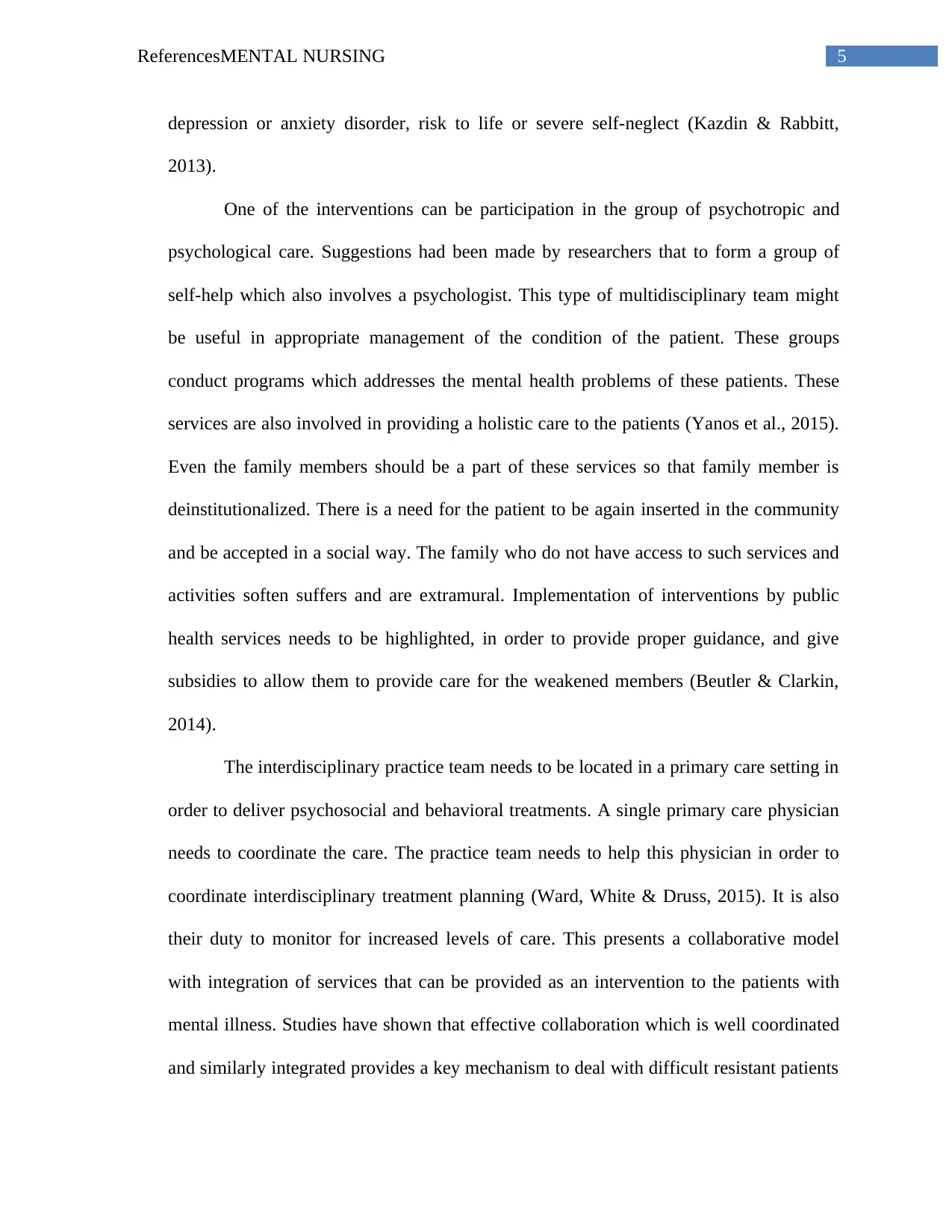
5ReferencesMENTAL NURSING
depression or anxiety disorder, risk to life or severe self-neglect (Kazdin & Rabbitt,
2013).
One of the interventions can be participation in the group of psychotropic and
psychological care. Suggestions had been made by researchers that to form a group of
self-help which also involves a psychologist. This type of multidisciplinary team might
be useful in appropriate management of the condition of the patient. These groups
conduct programs which addresses the mental health problems of these patients. These
services are also involved in providing a holistic care to the patients (Yanos et al., 2015).
Even the family members should be a part of these services so that family member is
deinstitutionalized. There is a need for the patient to be again inserted in the community
and be accepted in a social way. The family who do not have access to such services and
activities soften suffers and are extramural. Implementation of interventions by public
health services needs to be highlighted, in order to provide proper guidance, and give
subsidies to allow them to provide care for the weakened members (Beutler & Clarkin,
2014).
The interdisciplinary practice team needs to be located in a primary care setting in
order to deliver psychosocial and behavioral treatments. A single primary care physician
needs to coordinate the care. The practice team needs to help this physician in order to
coordinate interdisciplinary treatment planning (Ward, White & Druss, 2015). It is also
their duty to monitor for increased levels of care. This presents a collaborative model
with integration of services that can be provided as an intervention to the patients with
mental illness. Studies have shown that effective collaboration which is well coordinated
and similarly integrated provides a key mechanism to deal with difficult resistant patients
depression or anxiety disorder, risk to life or severe self-neglect (Kazdin & Rabbitt,
2013).
One of the interventions can be participation in the group of psychotropic and
psychological care. Suggestions had been made by researchers that to form a group of
self-help which also involves a psychologist. This type of multidisciplinary team might
be useful in appropriate management of the condition of the patient. These groups
conduct programs which addresses the mental health problems of these patients. These
services are also involved in providing a holistic care to the patients (Yanos et al., 2015).
Even the family members should be a part of these services so that family member is
deinstitutionalized. There is a need for the patient to be again inserted in the community
and be accepted in a social way. The family who do not have access to such services and
activities soften suffers and are extramural. Implementation of interventions by public
health services needs to be highlighted, in order to provide proper guidance, and give
subsidies to allow them to provide care for the weakened members (Beutler & Clarkin,
2014).
The interdisciplinary practice team needs to be located in a primary care setting in
order to deliver psychosocial and behavioral treatments. A single primary care physician
needs to coordinate the care. The practice team needs to help this physician in order to
coordinate interdisciplinary treatment planning (Ward, White & Druss, 2015). It is also
their duty to monitor for increased levels of care. This presents a collaborative model
with integration of services that can be provided as an intervention to the patients with
mental illness. Studies have shown that effective collaboration which is well coordinated
and similarly integrated provides a key mechanism to deal with difficult resistant patients
⊘ This is a preview!⊘
Do you want full access?
Subscribe today to unlock all pages.

Trusted by 1+ million students worldwide
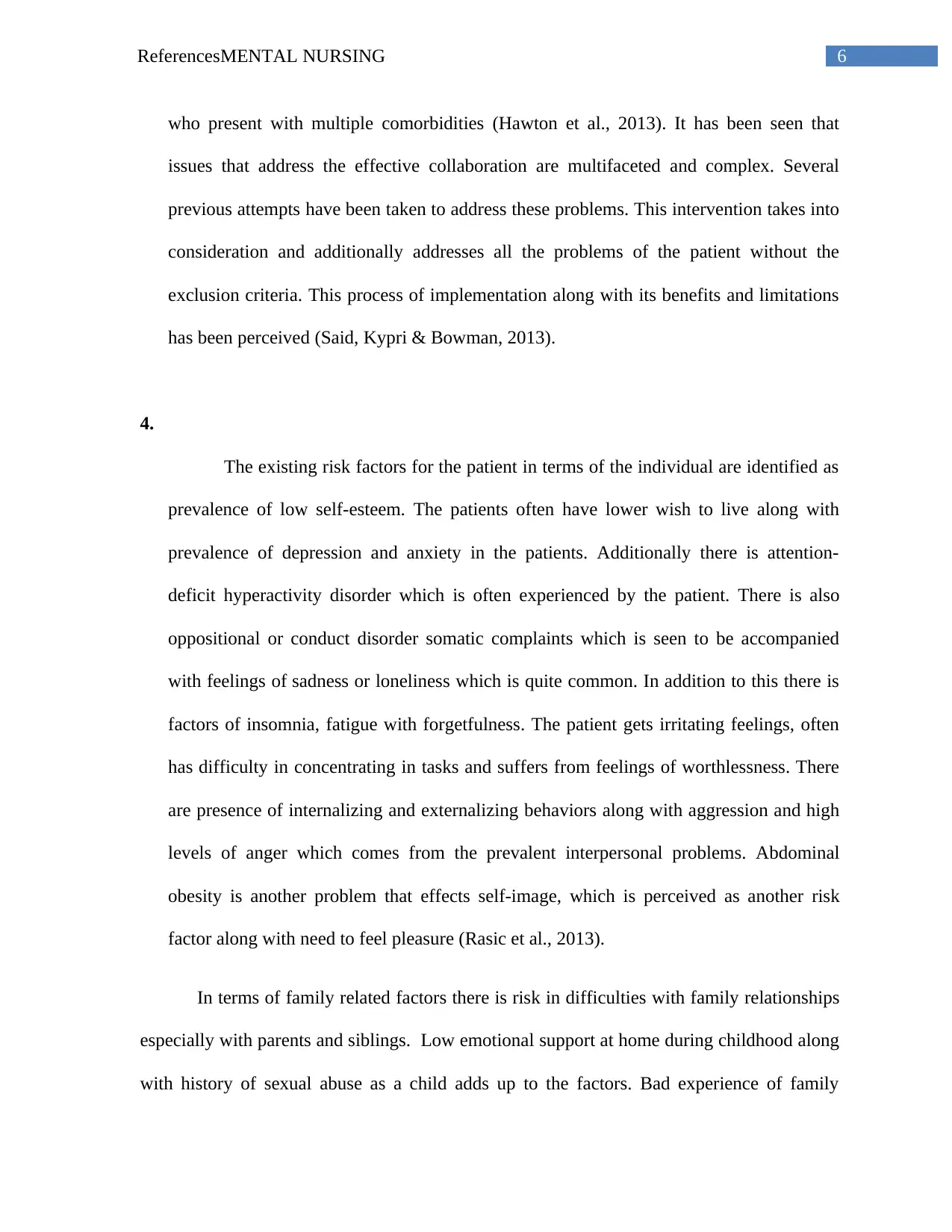
6ReferencesMENTAL NURSING
who present with multiple comorbidities (Hawton et al., 2013). It has been seen that
issues that address the effective collaboration are multifaceted and complex. Several
previous attempts have been taken to address these problems. This intervention takes into
consideration and additionally addresses all the problems of the patient without the
exclusion criteria. This process of implementation along with its benefits and limitations
has been perceived (Said, Kypri & Bowman, 2013).
4.
The existing risk factors for the patient in terms of the individual are identified as
prevalence of low self-esteem. The patients often have lower wish to live along with
prevalence of depression and anxiety in the patients. Additionally there is attention-
deficit hyperactivity disorder which is often experienced by the patient. There is also
oppositional or conduct disorder somatic complaints which is seen to be accompanied
with feelings of sadness or loneliness which is quite common. In addition to this there is
factors of insomnia, fatigue with forgetfulness. The patient gets irritating feelings, often
has difficulty in concentrating in tasks and suffers from feelings of worthlessness. There
are presence of internalizing and externalizing behaviors along with aggression and high
levels of anger which comes from the prevalent interpersonal problems. Abdominal
obesity is another problem that effects self-image, which is perceived as another risk
factor along with need to feel pleasure (Rasic et al., 2013).
In terms of family related factors there is risk in difficulties with family relationships
especially with parents and siblings. Low emotional support at home during childhood along
with history of sexual abuse as a child adds up to the factors. Bad experience of family
who present with multiple comorbidities (Hawton et al., 2013). It has been seen that
issues that address the effective collaboration are multifaceted and complex. Several
previous attempts have been taken to address these problems. This intervention takes into
consideration and additionally addresses all the problems of the patient without the
exclusion criteria. This process of implementation along with its benefits and limitations
has been perceived (Said, Kypri & Bowman, 2013).
4.
The existing risk factors for the patient in terms of the individual are identified as
prevalence of low self-esteem. The patients often have lower wish to live along with
prevalence of depression and anxiety in the patients. Additionally there is attention-
deficit hyperactivity disorder which is often experienced by the patient. There is also
oppositional or conduct disorder somatic complaints which is seen to be accompanied
with feelings of sadness or loneliness which is quite common. In addition to this there is
factors of insomnia, fatigue with forgetfulness. The patient gets irritating feelings, often
has difficulty in concentrating in tasks and suffers from feelings of worthlessness. There
are presence of internalizing and externalizing behaviors along with aggression and high
levels of anger which comes from the prevalent interpersonal problems. Abdominal
obesity is another problem that effects self-image, which is perceived as another risk
factor along with need to feel pleasure (Rasic et al., 2013).
In terms of family related factors there is risk in difficulties with family relationships
especially with parents and siblings. Low emotional support at home during childhood along
with history of sexual abuse as a child adds up to the factors. Bad experience of family
Paraphrase This Document
Need a fresh take? Get an instant paraphrase of this document with our AI Paraphraser
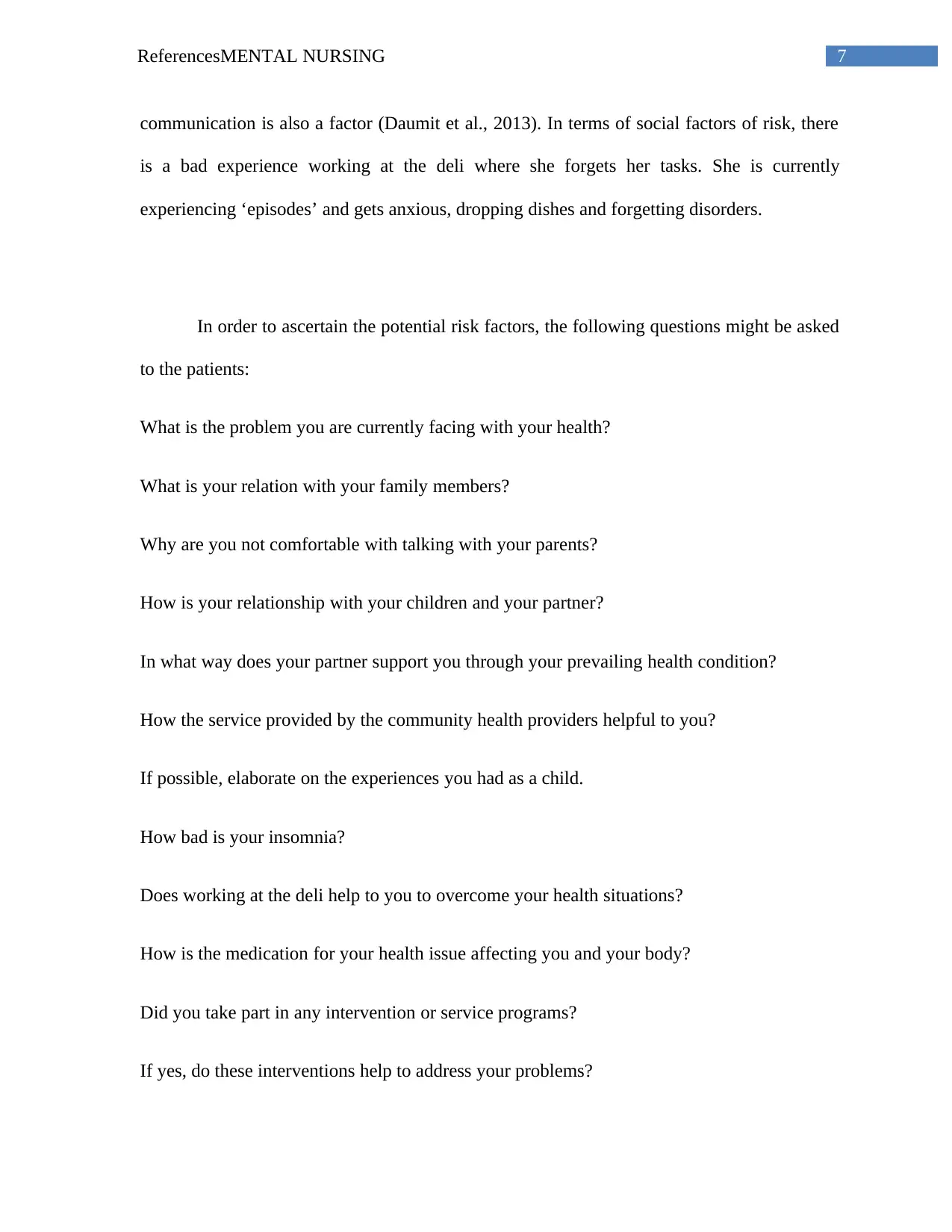
7ReferencesMENTAL NURSING
communication is also a factor (Daumit et al., 2013). In terms of social factors of risk, there
is a bad experience working at the deli where she forgets her tasks. She is currently
experiencing ‘episodes’ and gets anxious, dropping dishes and forgetting disorders.
In order to ascertain the potential risk factors, the following questions might be asked
to the patients:
What is the problem you are currently facing with your health?
What is your relation with your family members?
Why are you not comfortable with talking with your parents?
How is your relationship with your children and your partner?
In what way does your partner support you through your prevailing health condition?
How the service provided by the community health providers helpful to you?
If possible, elaborate on the experiences you had as a child.
How bad is your insomnia?
Does working at the deli help to you to overcome your health situations?
How is the medication for your health issue affecting you and your body?
Did you take part in any intervention or service programs?
If yes, do these interventions help to address your problems?
communication is also a factor (Daumit et al., 2013). In terms of social factors of risk, there
is a bad experience working at the deli where she forgets her tasks. She is currently
experiencing ‘episodes’ and gets anxious, dropping dishes and forgetting disorders.
In order to ascertain the potential risk factors, the following questions might be asked
to the patients:
What is the problem you are currently facing with your health?
What is your relation with your family members?
Why are you not comfortable with talking with your parents?
How is your relationship with your children and your partner?
In what way does your partner support you through your prevailing health condition?
How the service provided by the community health providers helpful to you?
If possible, elaborate on the experiences you had as a child.
How bad is your insomnia?
Does working at the deli help to you to overcome your health situations?
How is the medication for your health issue affecting you and your body?
Did you take part in any intervention or service programs?
If yes, do these interventions help to address your problems?
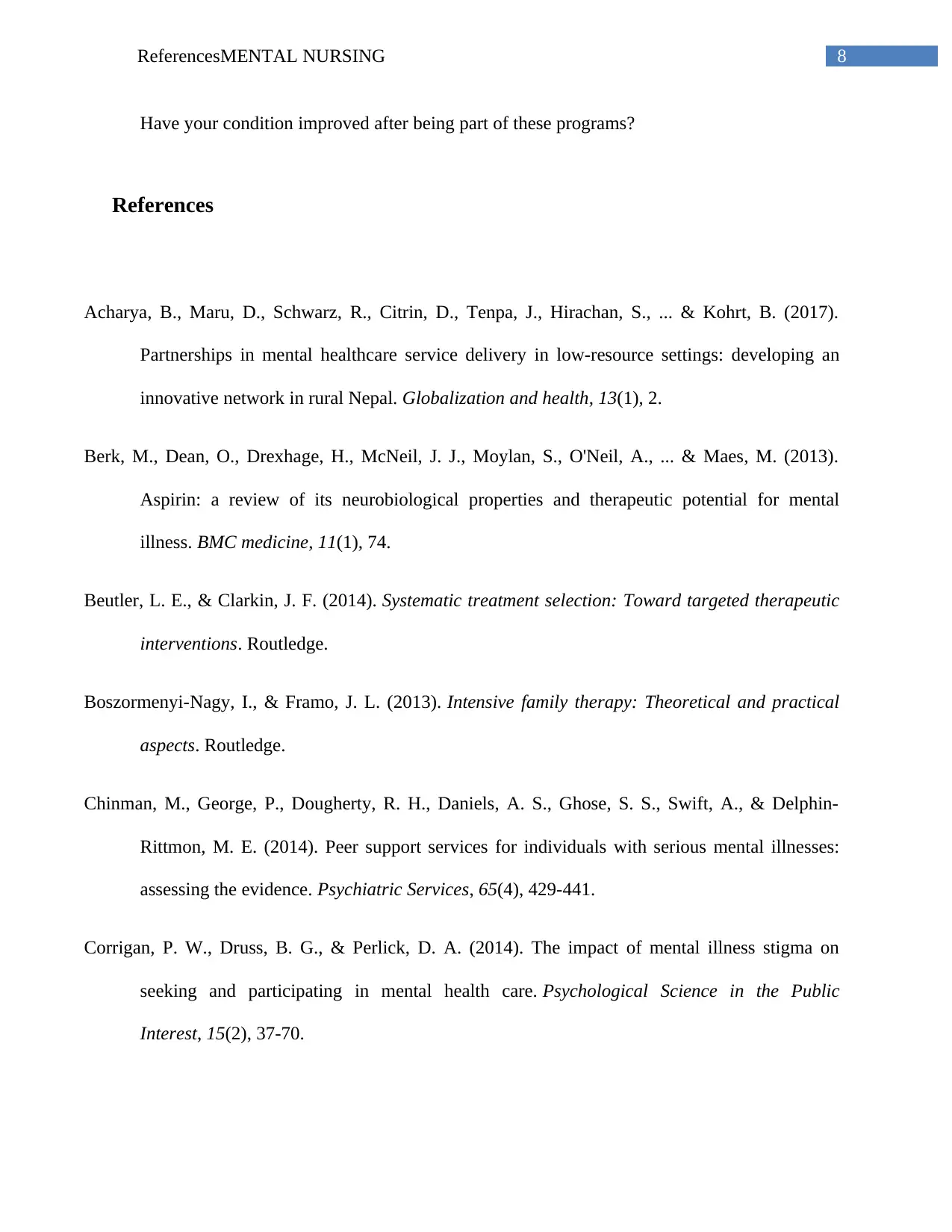
8ReferencesMENTAL NURSING
Have your condition improved after being part of these programs?
References
Acharya, B., Maru, D., Schwarz, R., Citrin, D., Tenpa, J., Hirachan, S., ... & Kohrt, B. (2017).
Partnerships in mental healthcare service delivery in low-resource settings: developing an
innovative network in rural Nepal. Globalization and health, 13(1), 2.
Berk, M., Dean, O., Drexhage, H., McNeil, J. J., Moylan, S., O'Neil, A., ... & Maes, M. (2013).
Aspirin: a review of its neurobiological properties and therapeutic potential for mental
illness. BMC medicine, 11(1), 74.
Beutler, L. E., & Clarkin, J. F. (2014). Systematic treatment selection: Toward targeted therapeutic
interventions. Routledge.
Boszormenyi-Nagy, I., & Framo, J. L. (2013). Intensive family therapy: Theoretical and practical
aspects. Routledge.
Chinman, M., George, P., Dougherty, R. H., Daniels, A. S., Ghose, S. S., Swift, A., & Delphin-
Rittmon, M. E. (2014). Peer support services for individuals with serious mental illnesses:
assessing the evidence. Psychiatric Services, 65(4), 429-441.
Corrigan, P. W., Druss, B. G., & Perlick, D. A. (2014). The impact of mental illness stigma on
seeking and participating in mental health care. Psychological Science in the Public
Interest, 15(2), 37-70.
Have your condition improved after being part of these programs?
References
Acharya, B., Maru, D., Schwarz, R., Citrin, D., Tenpa, J., Hirachan, S., ... & Kohrt, B. (2017).
Partnerships in mental healthcare service delivery in low-resource settings: developing an
innovative network in rural Nepal. Globalization and health, 13(1), 2.
Berk, M., Dean, O., Drexhage, H., McNeil, J. J., Moylan, S., O'Neil, A., ... & Maes, M. (2013).
Aspirin: a review of its neurobiological properties and therapeutic potential for mental
illness. BMC medicine, 11(1), 74.
Beutler, L. E., & Clarkin, J. F. (2014). Systematic treatment selection: Toward targeted therapeutic
interventions. Routledge.
Boszormenyi-Nagy, I., & Framo, J. L. (2013). Intensive family therapy: Theoretical and practical
aspects. Routledge.
Chinman, M., George, P., Dougherty, R. H., Daniels, A. S., Ghose, S. S., Swift, A., & Delphin-
Rittmon, M. E. (2014). Peer support services for individuals with serious mental illnesses:
assessing the evidence. Psychiatric Services, 65(4), 429-441.
Corrigan, P. W., Druss, B. G., & Perlick, D. A. (2014). The impact of mental illness stigma on
seeking and participating in mental health care. Psychological Science in the Public
Interest, 15(2), 37-70.
⊘ This is a preview!⊘
Do you want full access?
Subscribe today to unlock all pages.

Trusted by 1+ million students worldwide
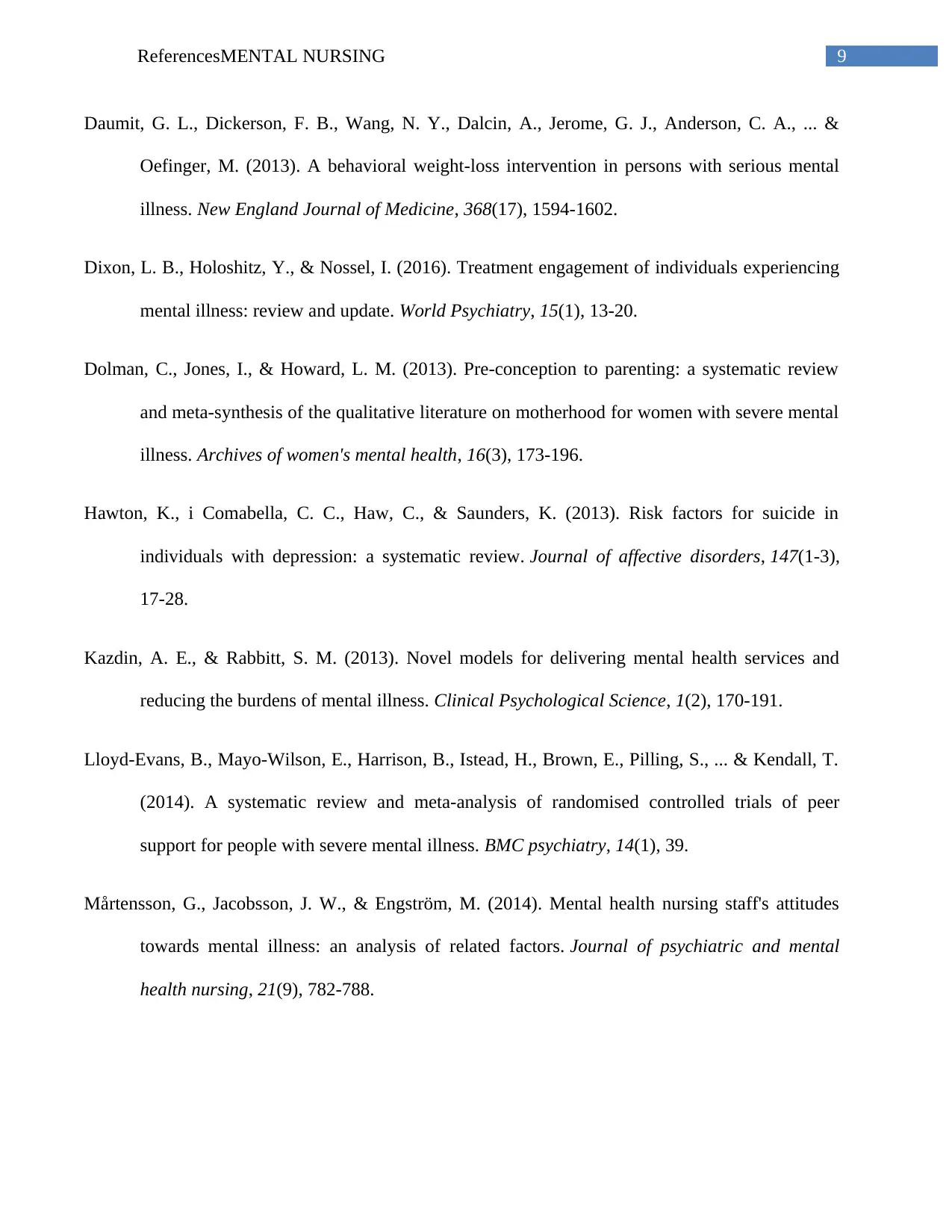
9ReferencesMENTAL NURSING
Daumit, G. L., Dickerson, F. B., Wang, N. Y., Dalcin, A., Jerome, G. J., Anderson, C. A., ... &
Oefinger, M. (2013). A behavioral weight-loss intervention in persons with serious mental
illness. New England Journal of Medicine, 368(17), 1594-1602.
Dixon, L. B., Holoshitz, Y., & Nossel, I. (2016). Treatment engagement of individuals experiencing
mental illness: review and update. World Psychiatry, 15(1), 13-20.
Dolman, C., Jones, I., & Howard, L. M. (2013). Pre-conception to parenting: a systematic review
and meta-synthesis of the qualitative literature on motherhood for women with severe mental
illness. Archives of women's mental health, 16(3), 173-196.
Hawton, K., i Comabella, C. C., Haw, C., & Saunders, K. (2013). Risk factors for suicide in
individuals with depression: a systematic review. Journal of affective disorders, 147(1-3),
17-28.
Kazdin, A. E., & Rabbitt, S. M. (2013). Novel models for delivering mental health services and
reducing the burdens of mental illness. Clinical Psychological Science, 1(2), 170-191.
Lloyd-Evans, B., Mayo-Wilson, E., Harrison, B., Istead, H., Brown, E., Pilling, S., ... & Kendall, T.
(2014). A systematic review and meta-analysis of randomised controlled trials of peer
support for people with severe mental illness. BMC psychiatry, 14(1), 39.
Mårtensson, G., Jacobsson, J. W., & Engström, M. (2014). Mental health nursing staff's attitudes
towards mental illness: an analysis of related factors. Journal of psychiatric and mental
health nursing, 21(9), 782-788.
Daumit, G. L., Dickerson, F. B., Wang, N. Y., Dalcin, A., Jerome, G. J., Anderson, C. A., ... &
Oefinger, M. (2013). A behavioral weight-loss intervention in persons with serious mental
illness. New England Journal of Medicine, 368(17), 1594-1602.
Dixon, L. B., Holoshitz, Y., & Nossel, I. (2016). Treatment engagement of individuals experiencing
mental illness: review and update. World Psychiatry, 15(1), 13-20.
Dolman, C., Jones, I., & Howard, L. M. (2013). Pre-conception to parenting: a systematic review
and meta-synthesis of the qualitative literature on motherhood for women with severe mental
illness. Archives of women's mental health, 16(3), 173-196.
Hawton, K., i Comabella, C. C., Haw, C., & Saunders, K. (2013). Risk factors for suicide in
individuals with depression: a systematic review. Journal of affective disorders, 147(1-3),
17-28.
Kazdin, A. E., & Rabbitt, S. M. (2013). Novel models for delivering mental health services and
reducing the burdens of mental illness. Clinical Psychological Science, 1(2), 170-191.
Lloyd-Evans, B., Mayo-Wilson, E., Harrison, B., Istead, H., Brown, E., Pilling, S., ... & Kendall, T.
(2014). A systematic review and meta-analysis of randomised controlled trials of peer
support for people with severe mental illness. BMC psychiatry, 14(1), 39.
Mårtensson, G., Jacobsson, J. W., & Engström, M. (2014). Mental health nursing staff's attitudes
towards mental illness: an analysis of related factors. Journal of psychiatric and mental
health nursing, 21(9), 782-788.
Paraphrase This Document
Need a fresh take? Get an instant paraphrase of this document with our AI Paraphraser
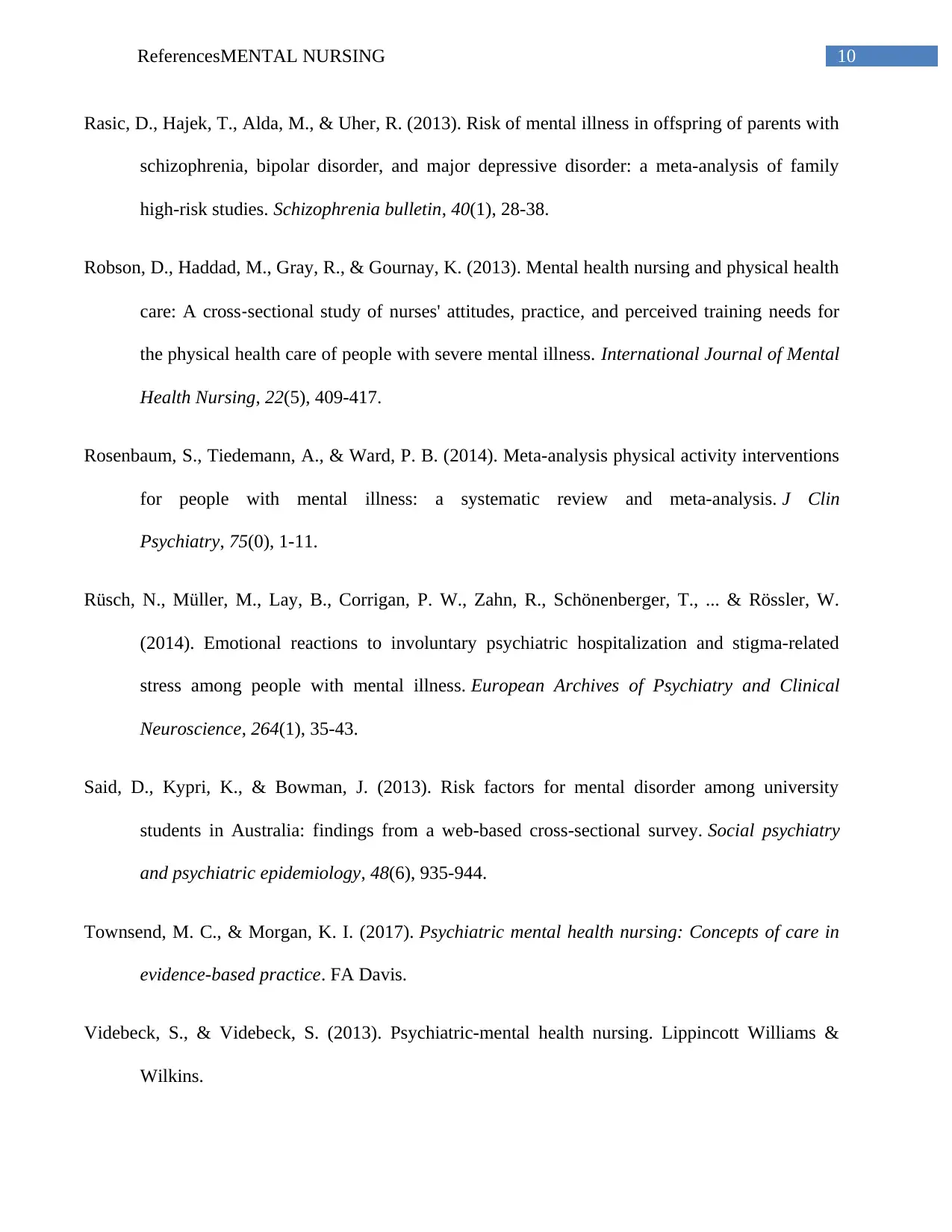
10ReferencesMENTAL NURSING
Rasic, D., Hajek, T., Alda, M., & Uher, R. (2013). Risk of mental illness in offspring of parents with
schizophrenia, bipolar disorder, and major depressive disorder: a meta-analysis of family
high-risk studies. Schizophrenia bulletin, 40(1), 28-38.
Robson, D., Haddad, M., Gray, R., & Gournay, K. (2013). Mental health nursing and physical health
care: A cross‐sectional study of nurses' attitudes, practice, and perceived training needs for
the physical health care of people with severe mental illness. International Journal of Mental
Health Nursing, 22(5), 409-417.
Rosenbaum, S., Tiedemann, A., & Ward, P. B. (2014). Meta-analysis physical activity interventions
for people with mental illness: a systematic review and meta-analysis. J Clin
Psychiatry, 75(0), 1-11.
Rüsch, N., Müller, M., Lay, B., Corrigan, P. W., Zahn, R., Schönenberger, T., ... & Rössler, W.
(2014). Emotional reactions to involuntary psychiatric hospitalization and stigma-related
stress among people with mental illness. European Archives of Psychiatry and Clinical
Neuroscience, 264(1), 35-43.
Said, D., Kypri, K., & Bowman, J. (2013). Risk factors for mental disorder among university
students in Australia: findings from a web-based cross-sectional survey. Social psychiatry
and psychiatric epidemiology, 48(6), 935-944.
Townsend, M. C., & Morgan, K. I. (2017). Psychiatric mental health nursing: Concepts of care in
evidence-based practice. FA Davis.
Videbeck, S., & Videbeck, S. (2013). Psychiatric-mental health nursing. Lippincott Williams &
Wilkins.
Rasic, D., Hajek, T., Alda, M., & Uher, R. (2013). Risk of mental illness in offspring of parents with
schizophrenia, bipolar disorder, and major depressive disorder: a meta-analysis of family
high-risk studies. Schizophrenia bulletin, 40(1), 28-38.
Robson, D., Haddad, M., Gray, R., & Gournay, K. (2013). Mental health nursing and physical health
care: A cross‐sectional study of nurses' attitudes, practice, and perceived training needs for
the physical health care of people with severe mental illness. International Journal of Mental
Health Nursing, 22(5), 409-417.
Rosenbaum, S., Tiedemann, A., & Ward, P. B. (2014). Meta-analysis physical activity interventions
for people with mental illness: a systematic review and meta-analysis. J Clin
Psychiatry, 75(0), 1-11.
Rüsch, N., Müller, M., Lay, B., Corrigan, P. W., Zahn, R., Schönenberger, T., ... & Rössler, W.
(2014). Emotional reactions to involuntary psychiatric hospitalization and stigma-related
stress among people with mental illness. European Archives of Psychiatry and Clinical
Neuroscience, 264(1), 35-43.
Said, D., Kypri, K., & Bowman, J. (2013). Risk factors for mental disorder among university
students in Australia: findings from a web-based cross-sectional survey. Social psychiatry
and psychiatric epidemiology, 48(6), 935-944.
Townsend, M. C., & Morgan, K. I. (2017). Psychiatric mental health nursing: Concepts of care in
evidence-based practice. FA Davis.
Videbeck, S., & Videbeck, S. (2013). Psychiatric-mental health nursing. Lippincott Williams &
Wilkins.
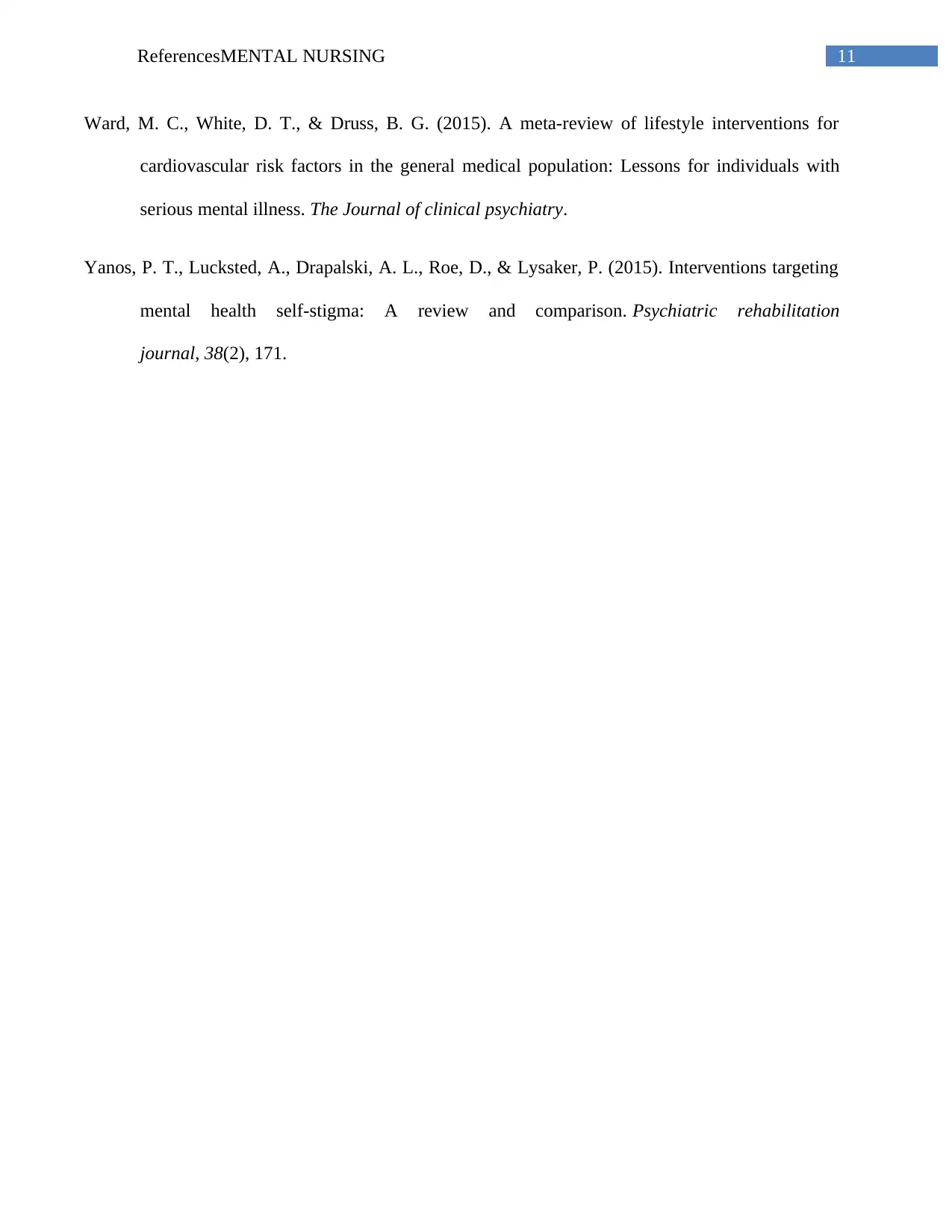
11ReferencesMENTAL NURSING
Ward, M. C., White, D. T., & Druss, B. G. (2015). A meta-review of lifestyle interventions for
cardiovascular risk factors in the general medical population: Lessons for individuals with
serious mental illness. The Journal of clinical psychiatry.
Yanos, P. T., Lucksted, A., Drapalski, A. L., Roe, D., & Lysaker, P. (2015). Interventions targeting
mental health self-stigma: A review and comparison. Psychiatric rehabilitation
journal, 38(2), 171.
Ward, M. C., White, D. T., & Druss, B. G. (2015). A meta-review of lifestyle interventions for
cardiovascular risk factors in the general medical population: Lessons for individuals with
serious mental illness. The Journal of clinical psychiatry.
Yanos, P. T., Lucksted, A., Drapalski, A. L., Roe, D., & Lysaker, P. (2015). Interventions targeting
mental health self-stigma: A review and comparison. Psychiatric rehabilitation
journal, 38(2), 171.
⊘ This is a preview!⊘
Do you want full access?
Subscribe today to unlock all pages.

Trusted by 1+ million students worldwide
1 out of 12
Related Documents
Your All-in-One AI-Powered Toolkit for Academic Success.
+13062052269
info@desklib.com
Available 24*7 on WhatsApp / Email
![[object Object]](/_next/static/media/star-bottom.7253800d.svg)
Unlock your academic potential
Copyright © 2020–2025 A2Z Services. All Rights Reserved. Developed and managed by ZUCOL.





